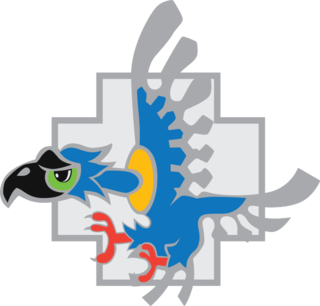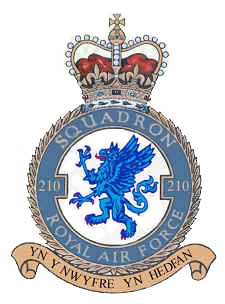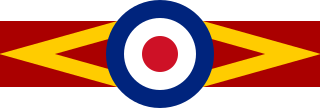
Number 111 (Fighter) Squadron, also known as No. CXI (F) Squadron and nicknamed Treble One, was a squadron of the Royal Air Force. It was formed in 1917 in the Middle East as No. 111 Squadron of the Royal Flying Corps during the reorganisation of the Egyptian Expeditionary Force after General Edmund Allenby took command during the Sinai and Palestine Campaign. The squadron remained in the Middle East after the end of the First World War until 1920 when it was renumbered as No. 14 Squadron.

Number 63 Squadron was a bomber aircraft and training squadron of the Royal Air Force that was active during various periods from 1916 to 1992. Originally using De Havilland DH4 aircraft in World War I, it was last equipped with BAe Hawk jet trainers.

No. 607 Squadron is an auxiliary squadron of the Royal Air Force. It was formed in 1930 as a bomber unit in the Auxiliary Air Force and changed in 1936 to the fighter role. It fought in that role during the Second World War in Europe and Asia. After the war, in 1946, the squadron reformed as a fighter unit. Awarded the title Royal Auxiliary Air Force by King George in 1947, 607 Sqn was disbanded with all the other flying units of the RAuxAF on 10 March 1957. It reformed on 5 January 2015, as a General Service Support Squadron (GSS).

Army Aviation Centre (AAC) Middle Wallop is a British Army airfield located near the Hampshire village of Middle Wallop, used for Army Air Corps training. The base hosts 2 (Training) Regiment AAC and 7 (Training) Regiment AAC under the umbrella of the Army Aviation Centre. 2 (Training) Regiment performs ground training; 7 (Training) Regiment trains aircrew on AAC aircraft after they complete basic training at RAF Shawbury.

The name No. 67 Squadron has been used by the Royal Flying Corps and the Royal Air Force for two quite different units.

No. 317 "City of Wilno" Polish Fighter Squadron was a Polish fighter squadron formed in Great Britain as part of an agreement between the Polish Government in Exile and the United Kingdom in 1941. It was one of several Polish fighter squadrons fighting alongside the Royal Air Force during World War II.
No. 242 Squadron RAF was a Royal Air Force (RAF) squadron. It flew in many roles during the First World War, Second World War and Cold War.

No. 210 Squadron was a Royal Air Force unit established in World War I. Disbanded and reformed a number of times in the ensuing years, it operated as a fighter squadron during World War I and as a maritime patrol squadron during the Spanish Civil War, World War II and the Cold War before it was last deactivated in 1971.

No. 239 Squadron RAF was an anti-submarine squadron of the Royal Air Force during World War I. During World War II the squadron performed as an army co-operation squadron and later as a night intruder unit. After the war the squadron was disbanded.
No. 204 Squadron was a Royal Air Force unit first formed in March 1915 as No.4 Squadron Royal Naval Air Service.

No. 80 Squadron RAF was a Royal Flying Corps and Royal Air Force squadron active from 1917 until 1969. It was operative during both World War I and World War II.
No. 232 Squadron of the Royal Air Force was active in both World War I and World War II in a variety of roles, having seen action as an anti-submarine patrol, fighter and transport squadron.
No. 137 Squadron RAF existed briefly as a day bomber unit in World War I but it never became operational. During World War II it flew as one of the two Whirlwind squadrons before converting to Hurricane Mk.IV fighter-bombers and later the Hawker Typhoon in the same role. The squadron was disbanded in August 1945.
No. 136 Squadron RAF was a short-lived RAF unit that saw no action in World War I, but upon reformation became the highest scoring unit in South East Asia Command during World War II. Shortly after the war the squadron was disbanded.
No. 126 Squadron RAF was a Royal Air Force Squadron formed to be a day bomber unit in World War I and reformed as a fighter unit in World War II.
No. 128 Squadron RAF was a Royal Air Force Squadron formed to be a day bomber unit in World War I and reformed as a fighter unit in World War II.
No. 131 Squadron RAF was a Royal Air Force Squadron formed to be a bomber unit in World War I and reformed as a fighter unit in World War II.
No. 132 Squadron RAF was a Royal Air Force Squadron formed to be a bomber unit in World War I and reformed as a fighter unit in World War II.
No. 135 Squadron RAF was a Royal Air Force Squadron formed to be a bomber unit in World War I and reformed as a fighter unit in World War II.
No. 154 Squadron RAF was a Royal Air Force squadron formed as a fighter unit in the Second World War.









